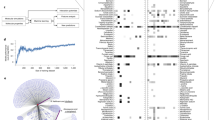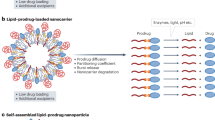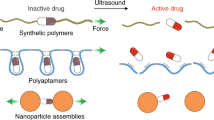Abstract
The conjugation of small molecular hydrophobic anticancer drugs onto a short peptide with overall hydrophilicity to create self-assembling drug amphiphiles offers a new prodrug strategy, producing well-defined, discrete nanostructures with a high and quantitative drug loading. Here we show the detailed synthesis procedure and how the molecular structure can influence the synthesis of the self-assembling prodrugs and the physicochemical properties of their assemblies. A series of camptothecin-based drug amphiphiles were synthesized via combined solid- and solution-phase synthetic techniques, and the physicochemical properties of their self-assembled nanostructures were probed using a number of imaging and spectroscopic techniques. We found that the number of incorporated drug molecules strongly influences the rate at which the drug amphiphiles are formed, exerting a steric hindrance toward any additional drugs to be conjugated and necessitating extended reaction time. The choice of peptide sequence was found to affect the solubility of the conjugates and, by extension, the critical aggregation concentration and contour length of the filamentous nanostructures formed. In the design of self-assembling drug amphiphiles, the number of conjugated drug molecules and the choice of peptide sequence have significant effects on the nanostructures formed. These observations may allow the fine-tuning of the physicochemical properties for specific drug delivery applications, ie systemic vs local delivery.
Similar content being viewed by others
Log in or create a free account to read this content
Gain free access to this article, as well as selected content from this journal and more on nature.com
or
References
Lien S, Lowman HB . Therapeutic peptides. Trends Biotechnol 2003; 21: 556–62.
Albericio F, Kruger HG . Therapeutic peptides. Future Med Chem 2012; 4: 1527–31.
Ahrens VM, Bellmann-Sickert K, Beck-Sickinger AG . Peptides and peptide conjugates: therapeutics on the upward path. Future Med Chem 2012; 4: 1567–86.
Arap W, Pasqualini R, Ruoslahti E . Cancer treatment by targeted drug delivery to tumor vasculature in a mouse model. Science 1998; 279: 377–80.
Burkhart DJ, Kalet BT, Coleman MP, Post GC, Koch TH . Doxorubicin-formaldehyde conjugates targeting αvβ3 integrin. Mol Cancer Ther 2004; 3: 1593–604.
Wang S, Placzek WJ, Stebbins JL, Mitra S, Noberini R, Koolpe M, et al. Novel targeted system to deliver chemotherapeutic drugs to EphA2-expressing cancer cells. J Med Chem 2012; 55: 2427–36.
Brooks H, Lebleu B, Vives E . Tat peptide-mediated cellular delivery: back to basics. Adv Drug Deliv Rev 2005; 57: 559–77.
Dubikovskaya EA, Thorne SH, Pillow TH, Contag CH, Wender PA . Overcoming multidrug resistance of small-molecule therapeutics through conjugation with releasable octaarginine transporters. Proc Natl Acad Sci U S A 2008; 105: 12128–33.
Soukasene S, Toft DJ, Moyer TJ, Lu HM, Lee HK, Standley SM, et al. Antitumor activity of peptide amphiphile nanofiber-encapsulated camptothecin. ACS Nano 2011; 5: 9113–21.
Zhang PC, Cheetham AG, Lock LL, Cui HG . Cellular uptake and cytotoxicity of drug-peptide conjugates regulated by conjugation site. Bioconjugate Chem 2013; 24: 604–13.
Wang Y, Cheetham AG, Angacian G, Su H, Xie L, Cui H . Peptide-drug conjugates as effective prodrug strategies for targeted delivery. Adv Drug Deliv Rev 2016; pii: S0169-409X(16) 30208-3.
Lin R, Zhang PC, Cheetham AG, Walston J, Abadir P, Cui HG . Dual peptide conjugation strategy for improved cellular uptake and mitochondria targeting. Bioconjugate Chem 2015; 26: 71–7.
Zompra AA, Galanis AS, Werbitzky O, Albericio F . Manufacturing peptides as active pharmaceutical ingredients. Future Med Chem 2009; 1: 361–77.
Su H, Koo JM, Cui HG . One-component nanomedicine. J Control Release 2015; 219: 383–95.
Hartgerink JD, Beniash E, Stupp SI . Self-assembly and mineralization of peptide-amphiphile nanofibers. Science 2001; 294: 1684–8.
Rajangam K, Behanna HA, Hui MJ, Han XQ, Hulvat JF, Lomasney JW, et al. Heparin binding nanostructures to promote growth of blood vessels. Nano Lett 2006; 6: 2086–90.
Standley SM, Toft DJ, Cheng H, Soukasene S, Chen J, Raja SM, et al. Induction of cancer cell death by self-assembling nanostructures incorporating a cytotoxic peptide. Cancer Res 2010; 70: 3020–6.
Pakalns T, Haverstick KL, Fields GB, McCarthy JB, Mooradian DL, Tirrell M . Cellular recognition of synthetic peptide amphiphiles in self-assembled monolayer films. Biomaterials 1999; 20: 2265–79.
Trent A, Marullo R, Lin B, Black M, Tirrell M . Structural properties of soluble peptide amphiphile micelles. Soft Matter 2011; 7: 9572–82.
Jun HW, Yuwono V, Paramonov SE, Hartgerink JD . Enzyme-mediated degradation of peptide-amphiphile nanofiber networks. Adv Mater 2005; 17: 2612–7.
Gauba V, Hartgerink JD . Self-assembled heterotrimeric collagen triple helices directed through electrostatic interactions. J Am Chem Soc 2007; 129: 2683–90.
Toledano S, Williams RJ, Jayawarna V, Ulijn RV . Enzyme-triggered self-assembly of peptide hydrogels via reversed hydrolysis. J Am Chem Soc 2006; 128: 1070–1.
Smith AM, Williams RJ, Tang C, Coppo P, Collins RF, Turner ML, et al. Fmoc-Diphenylalanine self assembles to a hydrogel via a novel architecture based on pi-pi interlocked beta-sheets. Adv Mater 2008; 20: 37–41.
Ceylan H, Tekinay AB, Guler MO . Selective adhesion and growth of vascular endothelial cells on bioactive peptide nanofiber functionalized stainless steel surface. Biomaterials 2011; 32: 8797–805.
Cinar G, Ceylan H, Urel M, Erkal TS, Tekin ED, Tekinay AB, et al. Amyloid inspired self-assembled peptide nanofibers. Biomacromolecules 2012; 13: 3377–87.
Schneider JP, Pochan DJ, Ozbas B, Rajagopal K, Pakstis L, Kretsinger J . Responsive hydrogels from the intramolecular folding and self-assembly of a designed peptide. J Am Chem Soc 2002; 124: 15030–7.
Li JY, Kuang Y, Gao Y, Du XW, Shi JF, Xu B . D-amino acids boost the selectivity and confer supramolecular hydrogels of a nonsteroidal anti-inflammatory drug (NSAID). J Am Chem Soc 2013; 135: 542–5.
Cheetham AG, Keith D, Zhang PC, Lin R, Su H, Cui HG . Targeting tumors with small molecule peptides. Curr Cancer Drug Targets 2016; 16: 489–508.
Su H, Zhang PC, Cheetham AG, Koo JM, Lin R, Masood A, et al. Supramolecular crafting of self-assembling camptothecin prodrugs with enhanced efficacy against primary cancer cells. Theranostics 2016; 6: 1065–74.
Lock LL, Tang Z, Keith D, Reyes C, Cui HG . Enzyme-specific doxorubicin drug beacon as drug-resistant theranostic molecular probes. ACS Macro Lett 2015; 4: 552–5.
Sievers EL, Linenberger M . Mylotarg: Antibody-targeted chemotherapy comes of age. Curr Opin Oncol 2001; 13: 522–7.
Younes A, Yasothan U, Kirkpatrick P . Brentuximab vedotin. Nat Rev Drug Discov 2012; 11: 19–20.
Traynor K . Ado-trastuzumab emtansine approved for advanced breast cancer. Am J Health Sys Pharm 2013; 70: 562.
Vlieghe P, Lisowski V, Martinez J, Khrestchatisky M . Synthetic therapeutic peptides: science and market. Drug Discov Today 2010; 15: 40–56.
Tang L, Persky AM, Hochhaus G, Meibohm B . Pharmacokinetic aspects of biotechnology products. J Pharm Sci 2004; 93: 2184–204.
Evans WE, Relling MV . Clinical pharmacokinetics-pharmacodynamics of anticancer drugs. Clin Pharmacokinet 1989; 16: 327–36.
Undevia SD, Gomez-Abuin G, Ratain MJ . Pharmacokinetic variability of anticancer agents. Nat Rev Cancer 2005; 5: 447–58.
Duncan R . Polymer conjugates as anticancer nanomedicines. Nat Rev Cancer 2006; 6: 688–701.
Tong R, Cheng J . Anticancer polymeric nanomedicines. Polym Rev 2007; 47: 345–81.
Cheng JJ, Khin KT, Jensen GS, Liu AJ, Davis ME . Synthesis of linear, beta-cyclodextrin-based polymers and their camptothecin conjugates. Bioconjugate Chem 2003; 14: 1007–17.
Zou J, Jafr G, Themistou E, Yap Y, Wintrob ZAP, Alexandridis P, et al. pH-Sensitive brush polymer-drug conjugates by ring-opening metathesis copolymerization. Chem Commun 2011; 47: 4493–5.
Yu Y, Chen CK, Law WC, Mok J, Zou J, Prasad PN, et al. Well-defined degradable brush polymer-drug conjugates for sustained delivery of paclitaxel. Mol Pharm 2013; 10: 867–74.
Gao Y, Kuang Y, Guo ZF, Guo ZH, Krauss IJ, Xu B . Enzyme-instructed molecular self-assembly confers nanofibers and a supramolecular hydrogel of taxol derivative. J Am Chem Soc 2009; 131: 13576–7.
Shen Y, Jin E, Zhang B, Murphy CJ, Sui M, Zhao J, et al. Prodrugs forming high drug loading multifunctional nanocapsules for intracellular cancer drug delivery. J Am Chem Soc 2010; 132: 4259–65.
Cheetham AG, Zhang P, Lin YA, Lock LL, Cui H . Supramolecular nanostructures formed by anticancer drug assembly. J Am Chem Soc 2013; 135: 2907–10.
Lin R, Cheetham AG, Zhang P, Lin YA, Cui H . Supramolecular filaments containing a fixed 41% paclitaxel loading. Chem Commun (Camb) 2013; 49: 4968–70.
Li XY, Yang CB, Zhang ZL, Wu ZD, Deng Y, Liang GL, et al. Folic acid as a versatile motif to construct molecular hydrogelators through conjugations with hydrophobic therapeutic agents. J Mater Chem 2012; 22: 21838–40.
Wang HM, Wei J, Yang CB, Zhao HY, Li DX, Yin ZN, et al. The inhibition of tumor growth and metastasis by self-assembled nanofibers of taxol. Biomaterials 2012; 33: 5848–53.
McDaniel JR, Bhattacharyya J, Vargo KB, Hassouneh W, Hammer DA, Chilkoti A . Self-assembly of thermally responsive nanoparticles of a genetically encoded peptide polymer by drug conjugation. Angew Chem Int Ed 2013; 52: 1683–7.
Lock LL, Reyes CD, Zhang PC, Cui HG . Tuning cellular uptake of molecular probes by rational design of their assembly into supramolecular nanoprobes. J Am Chem Soc 2016; 138: 3533–40.
Lin R, Cui HG . Supramolecular nanostructures as drug carriers. Curr Opin Chem Eng 2015; 7: 75–83.
Hu XY, Liu X, Zhang WY, Qin S, Yao CH, Li Y, et al. Controllable construction of biocompatible supramolecular micelles and vesicles by water-soluble phosphate pillar 5,6 arenes for selective anti-cancer drug delivery. Chem Mater 2016; 28: 3778–88.
Tan XY, Lu XG, Jia F, Liu XF, Sun YH, Logan JK, et al. Blurring the role of oligonucleotides: spherical nucleic acids as a drug delivery vehicle. J Am Chem Soc 2016; 138: 10834–7.
Sun Y, Kaplan JA, Shieh A, Sun HL, Croce CM, Grinstaff MW, et al. Self-assembly of a 5-fluorouracil-dipeptide hydrogel. Chem Commun 2016; 52: 5254–7.
Sun Y, Shieh A, Kim SH, King S, Kim A, Sun HL, et al. The self-assembly of a camptothecin-lysine nanotube. Bioorg Med Chem Lett 2016; 26: 2834–8.
Zhou Z, Munyaradzi O, Xia X, Green D, Bong D . High-capacity drug carriers from common polymer amphiphiles. Biomacromolecules 2016; 17: 3060–6.
Pommier Y . Topoisomerase I inhibitors: camptothecins and beyond. Nat Rev Cancer 2006; 6: 789–802.
Cheetham AG, Ou YC, Zhang PC, Cui HG . Linker-determined drug release mechanism of free camptothecin from self-assembling drug amphiphiles. Chem Commun 2014; 50: 6039–42.
Kang M, Zhang PC, Cui HG, Loverde SM . pi-pi Stacking mediated chirality in functional supramolecular filaments. Macromolecules 2016; 49: 994–1001.
Cui HG, Webber MJ, Stupp SI . Self-assembly of peptide amphiphiles: from molecules to nanostructures to biomaterials. Biopolymers 2010; 94: 1–18.
Hauser CAE, Zhang S . Designer self-assembling peptide nanofiber biological materials. Chem Soc Rev 2010; 39: 2780–90.
Kimura S, Kim DH, Sugiyama J, Imanishi Y . Vesicular self-assembly of a helical peptide in water. Langmuir 1999; 15: 4461–3.
Santoso S, Hwang W, Hartman H, Zhang SG . Self-assembly of surfactant-like peptides with variable glycine tails to form nanotubes and nanovesicles. Nano Lett 2002; 2: 687–91.
Jaracz S, Chen J, Kuznetsova LV, Ojima L . Recent advances in tumor-targeting anticancer drug conjugates. Bioorg Med Chem 2005; 13: 5043–54.
Byrne JD, Betancourt T, Brannon-Peppas L . Active targeting schemes for nanoparticle systems in cancer therapeutics. Adv Drug Deliv Rev 2008; 60: 1615–26.
Peng MY, Qin SY, Jia HZ, Zheng DW, Rong L, Zhang XZ . Self-delivery of a peptide-based prodrug for tumor-targeting therapy. Nano Res 2016; 9: 663–73.
Knop K, Hoogenboom R, Fischer D, Schubert US . Poly(ethylene glycol) in drug delivery: pros and cons as well as potential alternatives. Angew Chem Int Ed 2010; 49: 6288–308.
Sosnik A . Drug self-assembly: A phenomenon at the nanometer scale with major impact in the structure-biological properties relationship and the treatment of disease. Prog Mater Sci 2016; 82: 39–82.
MacKay JA, Chen M, McDaniel JR, Liu W, Simnick AJ, Chilkoti A . Self-assembling chimeric polypeptide-doxorubicin conjugate nanoparticles that abolish tumours after a single injection. Nat Mater 2009; 8: 993–9.
Dubowchik GM, Firestone RA . Cathepsin B-sensitive dipeptide prodrugs. 1. A model study of structural requirements for efficient release of doxorubicin. Bioorg Med Chem Lett 1998; 8: 3341–6.
Dubowchik GM, Mosure K, Knipe JO, Firestone RA . Cathepsin B-sensitive dipeptide prodrugs. 2. Models of anticancer drugs paclitaxel (Ttaxol (R)), mitomycin C and doxorubicin. Bioorg Med Chem Lett 1998; 8: 3347–52.
Cheng R, Feng F, Meng F, Deng C, Feijen J, Zhong Z . Glutathione-responsive nano-vehicles as a promising platform for targeted intracellular drug and gene delivery. J Control Release 2011; 152: 2–12.
Zhong T, Huang R, Tan LJ . Amphiphilic drug-drug assembly via dual-responsive linkages for small-molecule anticancer drug delivery. RSC Advances 2016; 6: 66420–30.
Andreu D, Albericio F, Sole NA, Munson MC, Ferrer M, Barany G . Formation of disulfide bonds in synthetic peptides and proteins. Meth Mol Biol 1994; 35: 91–169.
Hoyle CE, Bowman CN . Thiol-ene click chemistry. Angew Chem Int Ed 2010; 49: 1540–73.
Lutz JF, Zarafshani Z . Efficient construction of therapeutics, bioconjugates, biomaterials and bioactive surfaces using azide-alkyne “click” chemistry. Adv Drug Deliv Rev 2008; 60: 958–70.
Goux WJ, Kopplin L, Nguyen AD, Leak K, Rutkofsky M, Shanmuganandam VD, et al. The formation of straight and twisted filaments from short tau peptides. J Biol Chem 2004; 279: 26868–75.
Hu Y, Lin R, Patel K, Cheetham AG, Kan CY, Cui HG . Spatiotemporal control of the creation and immolation of peptide assemblies. Coord Chem Rev 2016; 320: 2–17.
Cheetham AG, Zhang P, Lin YA, Lin R, Cui H . Synthesis and self-assembly of a mikto-arm star dual drug amphiphile containing both paclitaxel and camptothecin. J Mater Chem B 2014; 2: 7316–26.
Lin YA, Cheetham AG, Zhang PC, Ou YC, Li YG, Liu GS, et al. Multiwalled nanotubes formed by catanionic mixtures of drug amphiphiles. ACS Nano 2014; 8: 12690–700.
Du XW, Zhou J, Shi JF, Xu B . Supramolecular hydrogelators and hydrogels: from soft matter to molecular biomaterials. Chem Rev 2015; 115: 13165–307.
Luo Y, Li M, Zhao YW, Liu H, Gong TX, Hong Y, et al. Molecular nanofibers of paclitaxel form supramolecular hydrogel for preventing tumor growth in vivo. RSC Advances 2016; 6: 80847–50.
Peltier R, Chen GC, Lei HP, Zhang M, Gao LQ, Lee SS, et al. The rational design of a peptide-based hydrogel responsive to H2S. Chem Commun 2015; 51: 17273–6.
Acknowledgements
The work is supported by the National Science Foundation (DMR 1255281), USA. We thank National Institutes of Health (NIH) for funding Andrew G CHEETHAM (T-32CA130840). We acknowledge the use of the Johns Hopkins Department of Chemistry NMR and Mass Spectrometry Shared Facilities and the Integrated Imaging Center for access to the relevant instrumentation. Financial support for MALDI-Tof analysis was provided by NSF Grant CHE-0840463. We thank Dr Phil MORTIMER for assistance with LC-MS and Prof Kalina HRISTOVA for use of the CD spectropolarimeter.
Author information
Authors and Affiliations
Corresponding author
Additional information
Supplementary information 1H and 13C NMR, HPLC chromatograms and mass spectrometric characterization of the purified materials can be found in the Supplementary Information on the website of Acta Pharmacologica Sinica.
Supplementary information
Supplementary Figures S1
Synthesis and molecular characterization (DOC 728 kb)
Supplementary Figures S2
Comparison of dCPT-buSS-Tau and dCPT-buSS-Sup35 (DOC 1385 kb)
Rights and permissions
About this article
Cite this article
Cheetham, A., Lin, Ya., Lin, R. et al. Molecular design and synthesis of self-assembling camptothecin drug amphiphiles. Acta Pharmacol Sin 38, 874–884 (2017). https://doi.org/10.1038/aps.2016.151
Received:
Accepted:
Published:
Issue date:
DOI: https://doi.org/10.1038/aps.2016.151
Keywords
This article is cited by
-
Cancer nanobiotechnolgy
Acta Pharmacologica Sinica (2017)
-
Recent progress in exploiting small molecule peptides as supramolecular hydrogelators
Chinese Journal of Polymer Science (2017)



